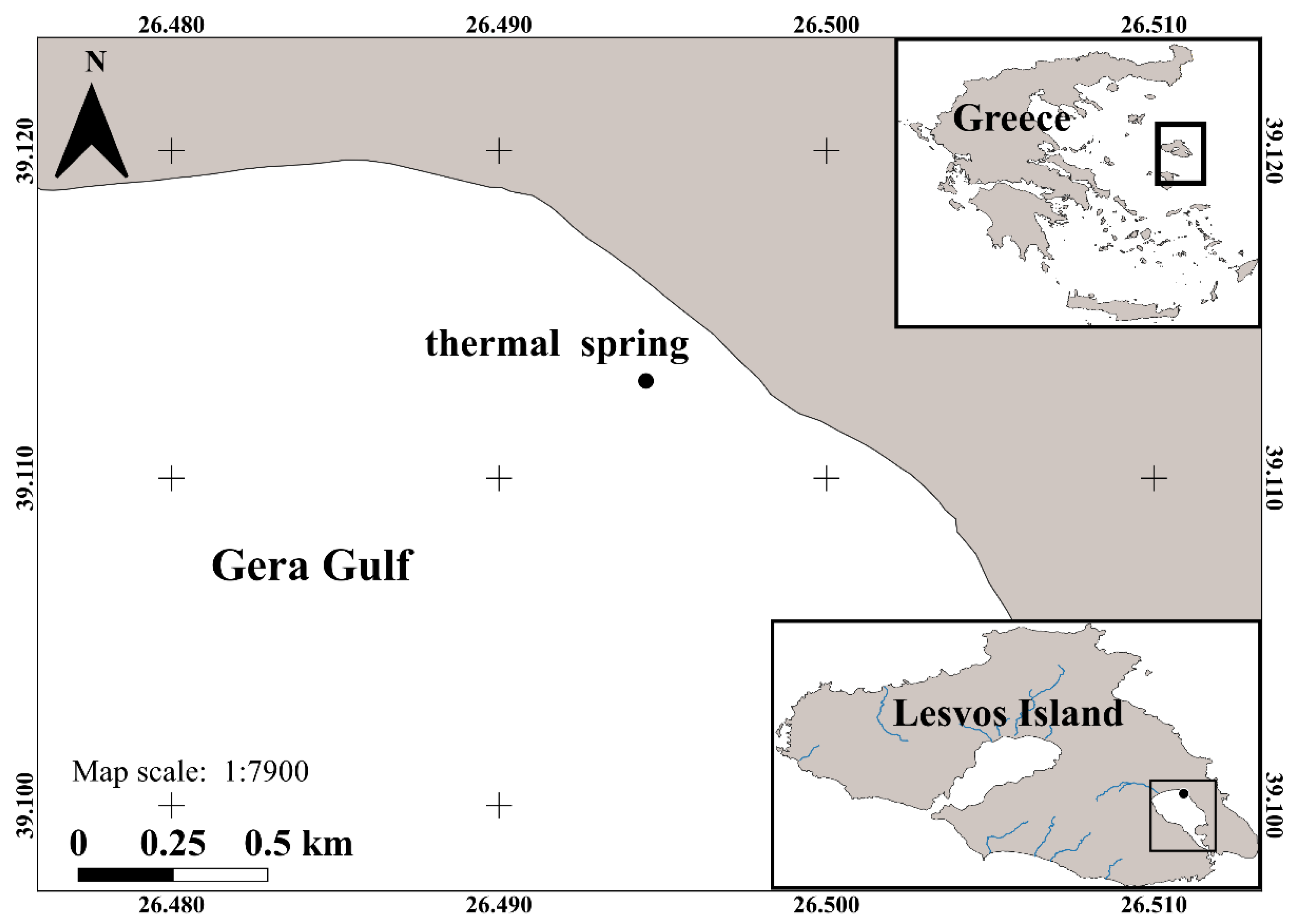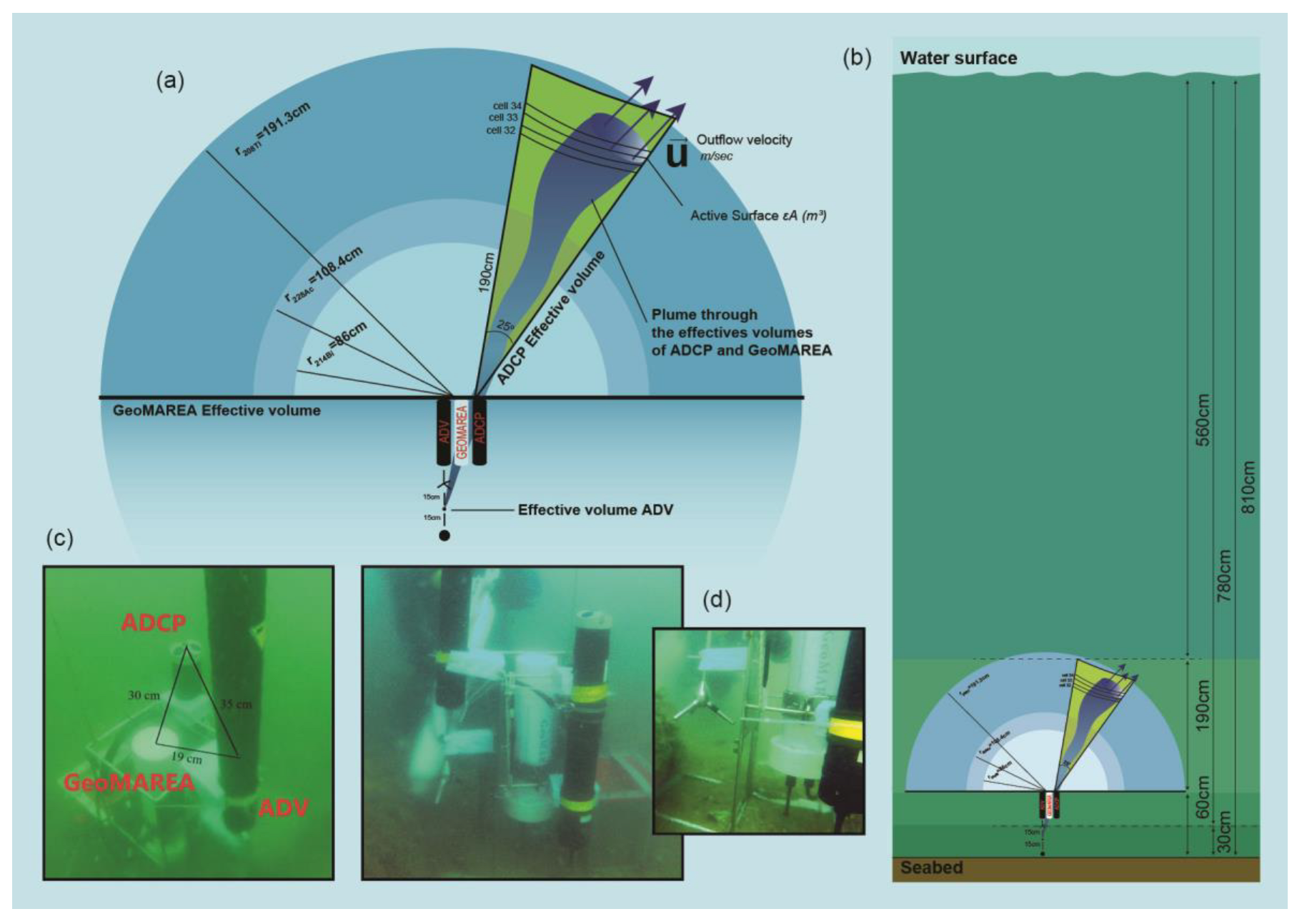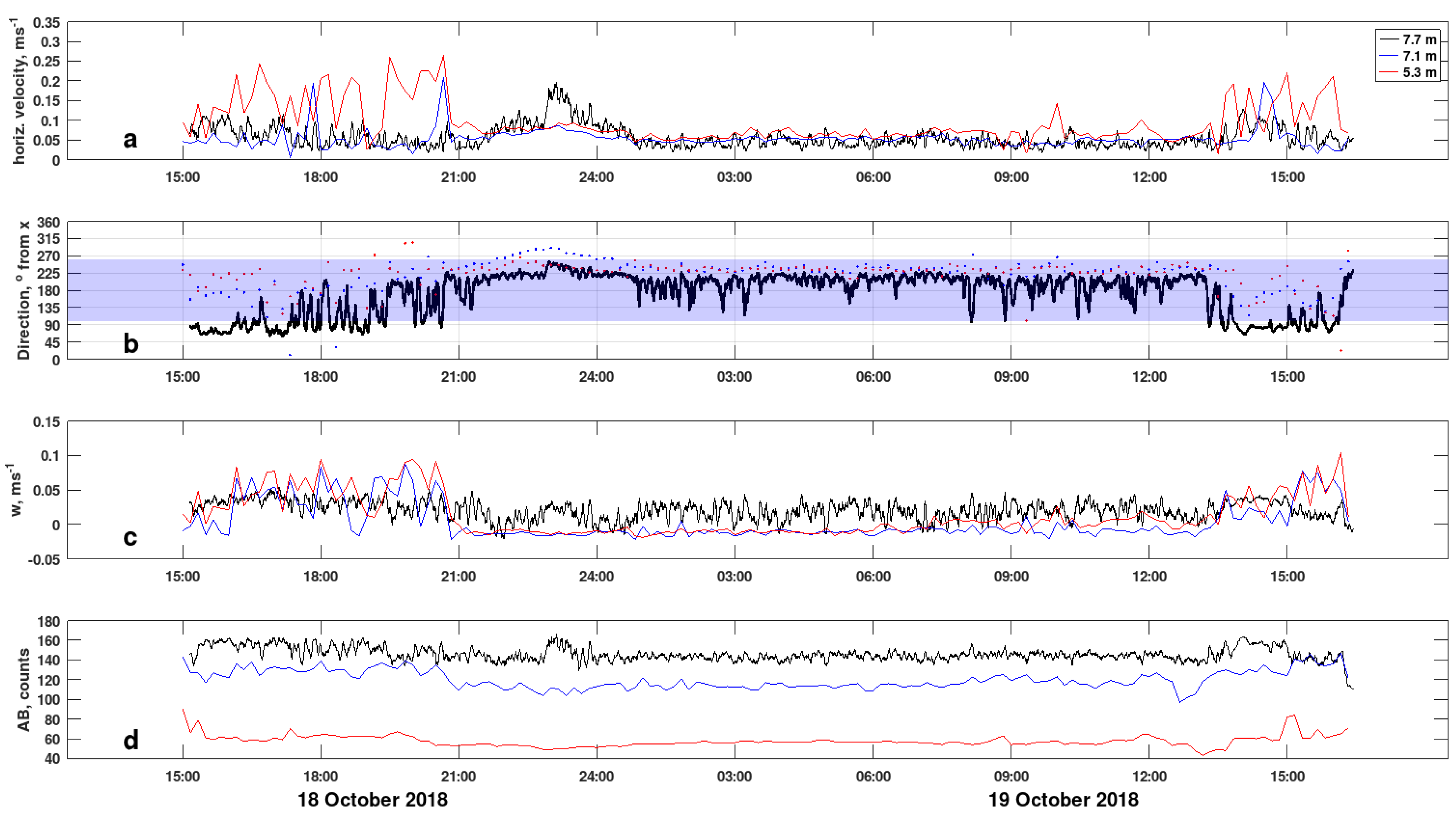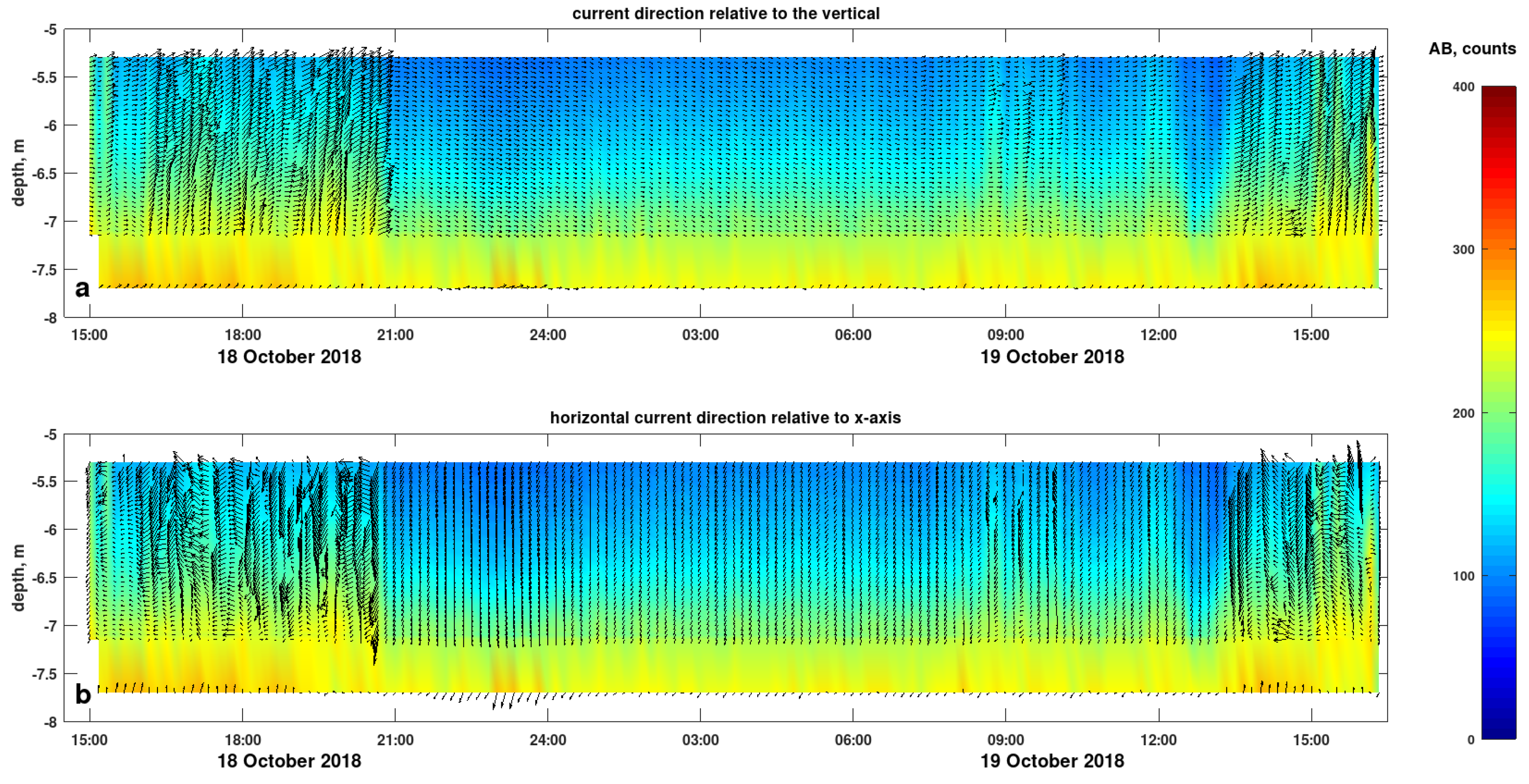In Situ Radioactivity Measurements and Water Flow Characteristics of a Thermal Spring in Gera Gulf, Lesvos Island, Greece
Abstract
1. Introduction
2. Study Area and Fieldwork
3. Materials and Methods
3.1. Instrumentation
3.1.1. Acoustic Doppler Measurements
3.1.2. GeoMAREA Detection System
3.2. Model Approaches
3.2.1. Residence Time
3.2.2. Discharge Rate of the Radionuclides
4. Results
4.1. Water Velocity and Acoustic Back-Scatter Observations
4.2. GeoMAREA Data
5. Discussion
5.1. Residence Time and Water Supply
5.2. Correlation of the Water Flow Velocity with Activity Concentration
6. Conclusions and Perspectives
Author Contributions
Funding
Institutional Review Board Statement
Informed Consent Statement
Data Availability Statement
Acknowledgments
Conflicts of Interest
References
- Garrison, G.; Glenn, C.R.; Mc Murtry, G.R. Measurement of submarine groundwater discharge in Kahana Bay, O′ahu, Hawai’i. Limnol. Oceanogr. 2003, 48, 920–928. [Google Scholar] [CrossRef]
- Taniguchi, M.; Ishitobi, T.; Saeki, K.-I. Evaluation of spacetime distributions of submarine groundwater discharge. Groundwater 2005, 43, 336–342. [Google Scholar] [CrossRef]
- Knee, K.L.; Street, J.H.; Grossman, E.E.; Boehm, A.B.; Paytan, A. Nutrient inputs to the coastal ocean from submarine groundwater discharge in a groundwater-dominated system relation to land use (Kona coast, Hawai’i, USA). Limnol. Oceanogr. 2010, 55, 1105–1122. [Google Scholar] [CrossRef]
- Crotwell, A.M.; Moore, W.S. Nutrient and radium fluxes from submarine groundwater discharge to Port Royal Sound, South Carolina. Aquat. Geochem. 2003, 9, 191–208. [Google Scholar] [CrossRef]
- Burnett, W.C.; Wattayakorn, G.; Taniguchi, M.; Dulaiova, H.; Sojisuporn, P.; Rungsupa, S.; Ishitobi, T. Groundwater derived nutrient inputs to the Upper Gulf of Thailand. Cont. Shelf Res. 2007, 27, 176–190. [Google Scholar] [CrossRef]
- Basu, A.R.; Jacobson, S.B.; Poreda, R.J.; Dowling, C.B.; Aggarwal, P.K. Large groundwater strontium flux to the oceans from the Bengal Basin and the marine strontium isotope record. Science 2001, 293, 1470–1473. [Google Scholar] [CrossRef]
- Montluçon, D.; Sañudo-Wilhelmy, S.A. Influence of net groundwater discharge on the chemical composition of a coastal environment: Flanders Bay, Long Island, New York. Environ. Sci. Technol. 2001, 35, 480–486. [Google Scholar] [CrossRef] [PubMed]
- McKenzie, T.; Dulai, H.; Fuleky, P. Traditional and novel time-series approaches reveal submarine groundwater discharge dynamics under baseline and extreme event conditions. Sci. Rep. 2021, 11, 22570. [Google Scholar] [CrossRef]
- Taniguchi, M.; Dulai, H.; Burnett, K.M.; Santos, I.R.; Sugimoto, R.; Stieglitz, T.; Kim, G.; Moosdorf, N.; Burnett, W.C. Submarine Groundwater Discharge: Updates on Its Measurement Techniques, Geophysical Drivers, Magnitudes, and Effects. Front. Environ. Sci. 2019, 7, 141. [Google Scholar] [CrossRef]
- Webb, J.R.; Santos, I.R.; Maher, D.T.; Tait, D.R.; Cyronak, T.; Sadat-Noori, M.; Macklin, P.; Jeffrey, L.C. Groundwater as a source of dissolved organic matter to coastal waters: Insights from radon and CDOM observations in 12 shallow coastal systems. Limnol. Oceanogr. 2019, 64, 182–196. [Google Scholar] [CrossRef]
- Cho, H.M.; Kim, G.; Kwon, E.Y.; Moosdorf, N.; Garcia-Orellana, J.; Santos, I.R. Radium tracing nutrient inputs through submarine groundwater discharge in the global ocean. Sci. Rep. 2018, 8, 2439. [Google Scholar] [CrossRef] [PubMed]
- McKenzie, T.; Holloway, C.; Dulai, H.; Tucker, J.P.; Sugimoto, R.; Nakajima, T.; Harada, K.; Santos, I.R. Submarine groundwater discharge: A previously undocumented source of contaminants of emerging concern to the coastal ocean (Sydney, Australia). Mar. Pollut. Bull. 2020, 160, 111519. [Google Scholar] [CrossRef]
- Tsabaris, C.; Scholten, J.; Karageorgis, A.P.; Comanducci, J.F.; Georgopoulos, D.; Liong Wee Kwong, L.; Patiris, D.L.; Papathanassiou, E. Underwater in situ measurements of radionuclides in selected submarine groundwater springs, Mediterranean Sea. Radiat. Prot. Dosim. 2010, 142, 273–281. [Google Scholar] [CrossRef] [PubMed]
- Tsabaris, C.; Anagnostou, M.N.; Patiris, D.L.; Nystuen, J.A.; Eleftheriou, G.; Dakladas, T.; Papadopoulos, V.; Prospathopoulos, A.; Papadopoulos, A.; Anagnostou, E.N. A marine groundwater spring in Stoupa, Greece: Shallow water instrumentation comparing radon and ambient sound with discharge rate. Procedia Earth Planet. Sci. 2011, 4, 3–9. [Google Scholar] [CrossRef]
- Tsabaris, C.; Patiris, D.L.; Karageorgis, A.P.; Eleftheriou, G.; Papadopoulos, V.P.; Georgopoulos, D.; Papathanassiou, E.; Povinec, P.P. In-situ radionuclide characterization of a submarine groundwater discharge site at Kalogria Bay, Stoupa, Greece. J. Environ. Radioact. 2012, 108, 50–59. [Google Scholar] [CrossRef] [PubMed]
- Dulai, H.; Kamenik, J.; Waters, C.A.; Kennedy, J.; Babinec, J.; Jolly, J.; Williamson, M. Autonomous long-term gamma-spectrometric monitoring of submarine groundwater discharge trends in Hawaii. J. Radioanal. Nucl. Chem. 2016, 307, 1865–1870. [Google Scholar] [CrossRef]
- Eleftheriou, G.; Tsabaris, C.; Patiris, D.L.; Androulakaki, E.G.; Vlastou, R. Estimation of coastal residence time of submarine groundwater discharge using radium progenies. Appl. Radiat. Isot. 2017, 121, 44–50. [Google Scholar] [CrossRef] [PubMed]
- Tsabaris, C.; Androulakaki, E.G.; Prospathopoulos, A.; Alexakis, S.; Eleftheriou, G.; Patiris, D.L.; Pappa, F.K.; Sarantakos, K.; Kokkoris, M.; Vlastou, R. Development and optimization of an underwater in-situ cerium bromide spectrometer for radioactivity measurements in the aquatic environment. J. Environ. Radioact. 2019, 204, 12–20. [Google Scholar] [CrossRef]
- Tsabaris, C.; Bagatelas, C.; Dakladas, T.; Papadopoulos, C.T.; Vlastou, R.; Chronis, G.T. An autonomous in situ detection system for radioactivity measurements in the marine environment. Appl. Radiat. Isot. 2008, 66, 1419–1426. [Google Scholar] [CrossRef]
- Bagatelas, C.; Tsabaris, C.; Kokkoris, M.; Papadopoulos, C.T.; Vlastou, R. Determination of marine gamma activity and study of the minimum detectable activity (MDA) in 4pi geometry based on Monte Carlo simulation. Environ. Monit. Assess. 2010, 165, 159. [Google Scholar] [CrossRef]
- Mendrinos, D.; Choropanitis, I.; Polyzou, O.; Karytsas, C. Exploring for geothermal resources in Greece. Geothermics 2009, 39, 124–137. [Google Scholar] [CrossRef]
- Bencini, A.; Duchi, V.; Casatello, A.; Kolios, N.; Fytikas, M.; Sbaragli, L. Geochemical study of fluids on Lesbos Island, Greece. Geothermics 2004, 33, 637–654. [Google Scholar] [CrossRef]
- Pavlides, S.; Tsapanos, T.; Zouros, N.; Sboras, S.; Koravos, G.; Chatzipetros, A. Using active fault data for assessing seismic hazard: A case study from NE Aegean Sea, Greece. In Proceedings of the 17th International Conference on Soil Mechanics & Geotechnical Engineering, Alexandria, Egypt, 2–3 October 2009. [Google Scholar]
- Anagnostou, C.; Sioulas, A. A sedimentological study of the Gulf of Geras (Lesvos) and the possible anthropogenic influence in the geochemical cycle of the region. Bull. Geol. Soc. Greece 1989, 23, 193–207. [Google Scholar]
- Lambrakis, N.J.; Stamatis, G.N. Contribution to the study of thermal waters in Greece: Chemical patterns and origin of thermal water in the thermal springs of Lesvos. Hydrol. Process 2008, 22, 171–180. [Google Scholar] [CrossRef]
- Arhonditsis, G.; Tsirtsis, G.; Angelidis, M.O.; Karydis, M. Quantification of the effects of nonpoint nutrient sources to coastal marine eutrophication: Applications to a semi-enclosed gulf in the Mediterranean Sea. Ecol. Model. 2000, 129, 209–227. [Google Scholar] [CrossRef]
- Tsirtsis, G.; Kitsiou, D.; Nitis, T.; Avagianou, E. Synthesis Report Gulf of Gera; DITTY Project Synthesis Report 2003; University of the Aegean: Lesvos, Greece, 2003. [Google Scholar]
- Arhonditsis, G.; Tsirtsis, G.; Karydis, M. The effects of episodic rainfall events to the dynamics of coastal marine ecosystems: Applications to a semi-enclosed gulf in the Meditteranean Sea. J. Mar. Syst. 2002, 35, 183–205. [Google Scholar] [CrossRef]
- Kolovoyiannis, V.; Tsirtsis, G. Implementation of a high resolution 3 dimensional hydrodynamic model to a shallow, semi-closed water body, Gulf of Gera-Lesvos. In Proceedings of the 9th International Conference on Environmental Science and Technology, Rhodes Island, Greece, 1–3 September 2005. [Google Scholar]
- Manoutsoglou, E.; Hasiotis, T.; Kyriakoudi, D.; Velegrakis, A.; Lowag, J. Puzzling micro-relief (mounds) of a soft-bottomed, semi-enclosed shallow marine environment. Geo-Mar. Lett. 2018, 38, 359–370. [Google Scholar] [CrossRef]
- Kraus, N.C.; Lohrmann, A.; Cabrera, R. New acoustic meter for measuring 3D laboratory flows. J. Hydraul. Eng. 1994, 120, 406–412. [Google Scholar] [CrossRef]
- Voulgaris, G.; Trowbridge, J.H. Evaluation of the Acoustic Doppler Velocimeter (ADV) for Turbulence Measurements. J. Atmosph. Ocean. Tech. 1998, 15, 272289. [Google Scholar] [CrossRef]
- McLelland, S.J.; Nicholas, A.P. A New Method for Evaluating Errors in High Frequency ADV Measurements. Hydrol. Process. 2000, 14, 351–366. [Google Scholar] [CrossRef]
- Chanson, H.; Trevethan, M.; Aoki, S. Acoustic doppler velocimetry (ADV) in a small estuarine system, field experience and “despiking”. In Proceedings of the 31st Biennial IAHR Congress, Seoul, Republic of Korea, 11–16 September 2005; Choi, G.W., Ed.; Theme E2, Paper 0161. International Association for Hydro-Environment Engineering and Research: Madrid, Spain; pp. 3954–3966. [Google Scholar]
- Chanson, H.; Aoki, S.; Maruyama, M. Unsteady Two-Dimensional Orifice Flow: An Experimental Study. In Coastal/Ocean Engineering Report, No. COE00-1; Department of Architecture and Civil Engineering, Toyohashi University of Technology: Toyohashi, Japan, 2000. [Google Scholar]
- Tropea, C. Laser Doppler anemometry: Recent Developments and future challenges. Meas. Sci. Technol. 1995, 6, 605. [Google Scholar] [CrossRef]
- Goring, D.G.; Nikora, V.I. Despiking acoustic Doppler velocimeter data. J. Hydraul. Eng. 2002, 128, 117–126. [Google Scholar] [CrossRef]
- Delcroix, T.; Masia, F.; Eldin, G. Comparison of profiling current meter and shipboard ADCP measurements in the western equatorial Pacific. J. Atmos. Oceanic Technol. 1992, 9, 867–871. [Google Scholar] [CrossRef]
- Lien, R.-C.; Mc Phaden, M.J.; Hebert, D. Intercomparison of ADCP measurements at 08, 1408W. J. Atmos. Oceanic Technol. 1994, 11, 1334–1349. [Google Scholar] [CrossRef]
- Winant, C.; Mettlach, T.; Larson, S. Comparison of buoy mounted 75-kHz acoustic Doppler current profilers with vector measuring current meters. J. Atmos. Oceanic Technol. 1994, 11, 1317–1333. [Google Scholar] [CrossRef]
- Irish, J.D.; Plueddemann, A.J.; Lentz, S.J. In-situ comparisons of moored acoustic Doppler profilers with conventional VACM and VMCM current meters. In Proceedings of the IEEE Fifth Working Conference on Current Measurement, St. Petersburg, FL, USA, 7–9 February 1995; IEEE: Piscataway, NJ, USA; pp. 59–64. [Google Scholar]
- Gordon, R. Acoustic Doppler Current Profiler: Principles of Operation, a Practical Primer, 2nd ed.; Teledyne RD Instruments Inc.: San Diego, CA, USA, 1996; Available online: http://misclab.umeoce.maine.edu/boss/classes/SMS_598_2012/RDI_BroadbandPrimer_ADCP.pdf (accessed on 25 July 2018).
- Holligan, P.M.; de Boois, H. Land-Ocean Interactions in the Coastal Zone (LOICZ) Science Plan. In IGBP Report no. 25; International Council of Scientific Unions: Stockholm, Sweden, 1993; p. 50. [Google Scholar]
- Kalfas, C.A.; Axiotis, M.; Tsabaris, C. SPECTRW: A software package for nuclear and atomic spectroscopy. Nucl. Instrum. Methods Phys. Res. Sect. A Accel. Spectrometers Detect. Assoc. Equip. 2016, 830, 265–274. [Google Scholar] [CrossRef]
- Kioroglou, S. On the probability of a displacement within an overturn: The influence of structural details of the potential density profile. In Proceedings of the 2014 Oceans—St. John’s, St. John’s, NL, Canada, 14–19 September 2014; pp. 1–8. [Google Scholar] [CrossRef]
- Kioroglou, S. On Independent Degrees of Freedom of Turbulent Mixing. Phys. Fluids 2021, 33, 105125. [Google Scholar] [CrossRef]





Disclaimer/Publisher’s Note: The statements, opinions and data contained in all publications are solely those of the individual author(s) and contributor(s) and not of MDPI and/or the editor(s). MDPI and/or the editor(s) disclaim responsibility for any injury to people or property resulting from any ideas, methods, instructions or products referred to in the content. |
© 2023 by the authors. Licensee MDPI, Basel, Switzerland. This article is an open access article distributed under the terms and conditions of the Creative Commons Attribution (CC BY) license (https://creativecommons.org/licenses/by/4.0/).
Share and Cite
Tsabaris, C.; Zervakis, V.; Saitanis, S.; Patiris, D.; Pappa, F.K.; Velegrakis, A.; Alexakis, S.; Kioroglou, S. In Situ Radioactivity Measurements and Water Flow Characteristics of a Thermal Spring in Gera Gulf, Lesvos Island, Greece. J. Mar. Sci. Eng. 2023, 11, 801. https://doi.org/10.3390/jmse11040801
Tsabaris C, Zervakis V, Saitanis S, Patiris D, Pappa FK, Velegrakis A, Alexakis S, Kioroglou S. In Situ Radioactivity Measurements and Water Flow Characteristics of a Thermal Spring in Gera Gulf, Lesvos Island, Greece. Journal of Marine Science and Engineering. 2023; 11(4):801. https://doi.org/10.3390/jmse11040801
Chicago/Turabian StyleTsabaris, Christos, Vassilis Zervakis, Spyros Saitanis, Dionisis Patiris, Filothei K. Pappa, Antonios Velegrakis, Stylianos Alexakis, and Sotirios Kioroglou. 2023. "In Situ Radioactivity Measurements and Water Flow Characteristics of a Thermal Spring in Gera Gulf, Lesvos Island, Greece" Journal of Marine Science and Engineering 11, no. 4: 801. https://doi.org/10.3390/jmse11040801
APA StyleTsabaris, C., Zervakis, V., Saitanis, S., Patiris, D., Pappa, F. K., Velegrakis, A., Alexakis, S., & Kioroglou, S. (2023). In Situ Radioactivity Measurements and Water Flow Characteristics of a Thermal Spring in Gera Gulf, Lesvos Island, Greece. Journal of Marine Science and Engineering, 11(4), 801. https://doi.org/10.3390/jmse11040801









